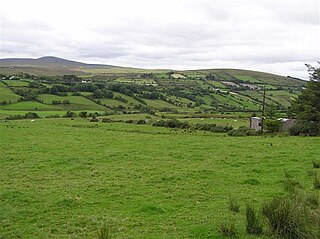
The East Tyrone Brigade of the Provisional Irish Republican Army (IRA), also known as the Tyrone/Monaghan Brigade was one of the most active republican paramilitary groups in Northern Ireland during "the Troubles". It is believed to have drawn its membership from across the eastern side of County Tyrone as well as north County Monaghan and south County Londonderry.
This is a chronology of activities by the Provisional Irish Republican Army (IRA) from 1970 to 1979.

The ambush at Drumnakilly was a military confrontation that took place at Drumnakilly in County Tyrone, Northern Ireland on 30 August 1988 during The Troubles, when a detachment of the Provisional IRA (IRA) was ambushed by the British Army.
The Troubles in Ballygawley recounts incidents during The Troubles in Ballygawley, County Tyrone, Northern Ireland.
On 7 December 1985 the Provisional Irish Republican Army (IRA) attacked the Royal Ulster Constabulary (RUC) base at Ballygawley, County Tyrone. Two RUC officers were shot dead and the base was raked with gunfire before being destroyed by a bomb, which wounded a further three officers.
This is a chronology of activities by the Provisional Irish Republican Army (IRA) from 1980 to 1989. For actions before and after this period see Chronology of Provisional Irish Republican Army actions.
This is a chronology of activities by the Provisional Irish Republican Army (IRA), from 1992 to 1999.

The Clonoe Ambush was a military action between the British Army and the Provisional Irish Republican Army (IRA) that occurred during The Troubles in Northern Ireland. On 16 February 1992, an IRA unit attacked the Royal Ulster Constabulary (RUC) security base in the village of Coalisland in County Tyrone, and was ambushed shortly afterwards by the Special Air Service (SAS) in the grounds of a church in the village of Clonoe whilst attempting to make its escape, resulting in several IRA fatalities.

The Coagh ambush was a military confrontation that took place in County Tyrone, Northern Ireland, on 3 June 1991, during The Troubles, when a Provisional Irish Republican Army (IRA) active service unit from its East Tyrone Brigade was ambushed by the British Army's Special Air Service (SAS) at the village of Coagh, in County Tyrone, whilst on its way to kill a part-time member of the Ulster Defence Regiment (UDR). The ambush resulted in the deaths of all three IRA men involved.

The Teebane bombing took place on 17 January 1992 at a rural crossroads between Omagh and Cookstown in County Tyrone, Northern Ireland. A roadside bomb destroyed a van carrying 14 construction workers who had been repairing a British Army base in Omagh. Eight of the men were killed and the rest were wounded. Most were civilians, while one of those killed and two of the wounded were off-duty British soldiers. The Provisional Irish Republican Army (IRA) claimed responsibility, saying the workers were targeted because they were collaborating with the "forces of occupation".

The Mullacreevie ambush took place on 1 March 1991, when a mobile patrol of the Ulster Defence Regiment composed of two Land Rover vehicles was attacked with an improvised horizontal mortar by a Provisional IRA active service unit from the North Armagh Brigade while passing near Mullacreevie housing estate, on the west side of Armagh City. One member of the UDR was killed instantly when the leading Land Rover was hit, while another died of wounds two days later. Two other soldiers were maimed for life.

In the Ballygawley land mine attack of 13 July 1983, four soldiers of the British Army's Ulster Defence Regiment (UDR) were killed by a Provisional Irish Republican Army (IRA) land mine near Ballygawley in County Tyrone, Northern Ireland. The soldiers were travelling in a convoy of armoured vehicles when the land mine was detonated remotely.
On 9 April 1990, the South Down Brigade of the Provisional Irish Republican Army (IRA) detonated a massive improvised land mine under a British Army convoy outside Downpatrick, County Down, Northern Ireland. Four soldiers of the Ulster Defence Regiment (UDR) were killed, the regiment's greatest loss of life since 1983.
In the Altnaveigh landmine attack of 19 May 1981, five British soldiers were killed and their armoured vehicle destroyed by a Provisional IRA landmine at Altnaveigh, a rural area outside Newry in County Armagh, Northern Ireland. The landmine was detonated remotely when the vehicle passed over it. The attack happened during a period of heightened tension over the 1981 Irish hunger strike.

The Strabane Ambush was a British Special Air Service ambush against a three man Provisional Irish Republican Army (IRA) unit. All three members of the IRA unit were killed in the ambush. At the time it was the most successful SAS operation against the IRA, until the Loughgall ambush two years later in 1987 in which eight IRA volunteers were killed.
In the Dungannon land mine attack of 16 December 1979, the Provisional Irish Republican Army (IRA) ambushed two British Army Land Rovers with an improvised land mine outside Dungannon, County Tyrone, Northern Ireland. Four British soldiers were killed in the attack.
Declan Arthurs was a Volunteer in the Provisional IRA's East Tyrone Brigade in the mid-1980s. He was killed in the Loughgall ambush, after bombing an RUC base.
This is a chronology of activities by the Provisional Irish Republican Army (IRA), in 1990 and 1991.
On 10 September 1972, an active service unit (ASU) of the Provisional IRA's East Tyrone Brigade carried out a landmine attack against a British Army mobile patrol, along a small road in the rural village of Sanaghanroe near the town of Dungannon in County Tyrone.








